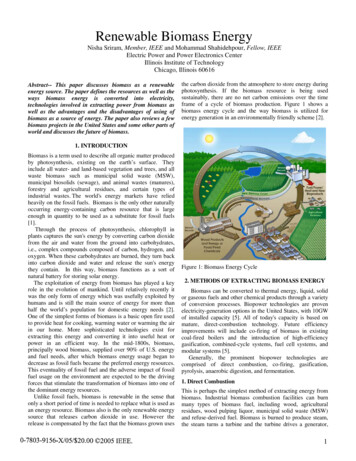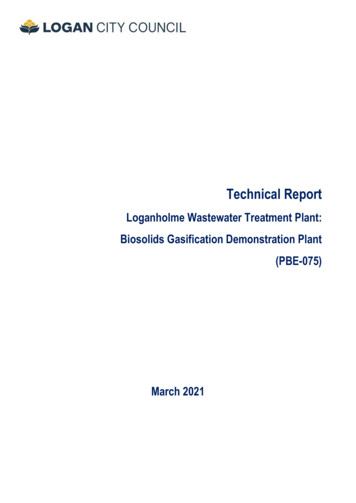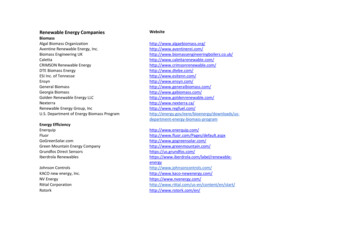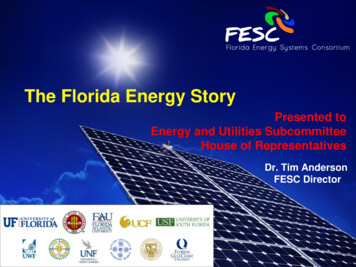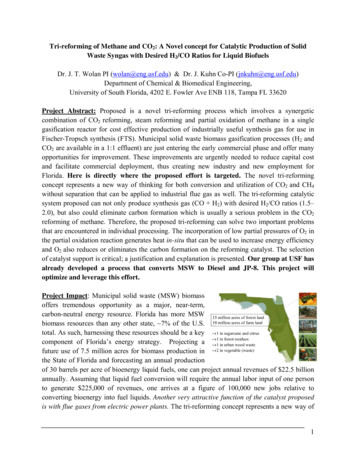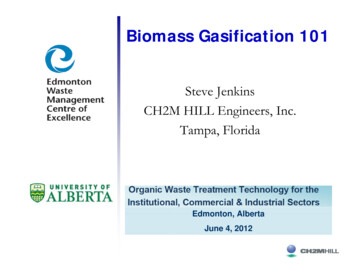
Transcription
Biomass Gasification 101Steve JenkinsCH2M HILL Engineers, Inc.Tampa, FloridaEdmonton, AlbertaJune 4, 2012
Topics What are pyrolysis and gasification? Historical uses for pyrolysis and gasification Biomass gasification technologies Municipal Solid Waste gasification– Gasification vs. Mass-burn Incineration Example projects2
What are Pyrolysis and tilizersChar/ash3
What is Pyrolysis? Thermal decomposition of organic materials at200-800 C, in the absence of air or oxygen, into liquids,gases or a combination of liquids and gases It’s not combustion; there’s no burning! A mixture of un-reacted carbon char and ash remains asa residual4
Pyrolysis at Home5
6
What is Gasification? Thermal conversion of carbon-based materials at 5001,500 C, with a limited supply of air or oxygen, into asynthetic gas, or syngas It’s not combustion; there’s no burning! Gasification uses only a fraction of the oxygen thatwould be needed to burn the material An ash/slag remains as a residual– Little to no un-reacted carbon char remains7
What’s in the Syngas? Syngas contains mostly hydrogen (H2), carbon monoxide(CO), carbon dioxide (CO2), and water (H2O)– it’s not methane (CH4), like natural gas Heating value is 5-16 MJ/kg (100-300 Btu/ft3)– vs. natural gas at 52 MJ/kg (1,000 Btu/ft3) Syngas can be used a fuel for generating power, or tomake chemicals, fuels, or fertilizers8
How has Pyrolysis been Used? Making charcoal from wood Making cooking additives Producing methanol (“spirit of wood”)– Used by Kodak to make photo film9
How has Gasification been Used? Making “town gas” from coal (1792) Manufactured gas plants – prior to discovery andwidespread use of natural gas10
Town Gas Holders11
Town Gas ProductionSchwarze Pumpe, Germany12
How has Gasification been Used? Cars and trucks used small wood gasifiers for fuelwood gasifier13
Biomass Gasification14
Feedstocks Wood waste (sawdust, bark) Cultivated crops (switchgrass) Agricultural wastes Animal wastes (stall waste) Waste Water Treatment Plantbiosolids Municipal solid waste (MSW) Blends15
Feedstock Comparisons% Moisture% Ash% Volatile Matter% CarbonMJ/kg (Btu/lb)Plastic22966032.5 (14,100)Pet Coke80.5108132.6 (14,050)Bituminous Coal1211356125.8 (11,100)Poplar51824719.5 (8,382)SubbituminousCoal305314818.9 (8,156)Corn Stover65764418.1 (7,782)Corn Cob62724617.1 (7,369)Paper105764415.8 (6,814)Pine170.5714215.8 (6,800)Switchgrass84673915.4 (6,636)Chicken Litter1219583214.6 (6,310)MSW2125525211.6 (5,000)Dried Biosolids102060108.0 (3,445)16
Biomass Gasification vs. Combustion Wide range of feedstocks Easier to gasify some feedstocks than to try to burn them Environmental advantages over biomass combustion:–Concentrates ash contaminants in the gasifier, so that the boiler,reciprocating engine or gas turbine burns syngas, not the actualbiomass–Syngas can be piped to multiple users–Ash/slag can be a usable by-product17
Biomass Gasifiers “Typical” biomass gasifiers:––––––20 kg/hr to 300 tonnes/dayAir-blownAtmospheric pressure500-1,000ºCFixed bed or fluid bedSyngas is combusted directly in a boiler to make steam for asteam turbine generator18
Biomass Gasifiers – Many Types for DifferentFeedstocks and Applications19
Fixed Bed Gasifier – Updraft Feedstock is pre-dried before itgets to gasification zone Can handle high moisturebiomass Heat source is oxidation ofchar Operates at low temperatures High amount of tar in syngas– Must be cleaned prior todownstream use20FeedstockSyngas, tarsC CO2 2COC H2O CO H2OxidationC O2 CO2
Fixed Bed Gasifier – Downdraft Needs low moisture( 20%) and low ash Fines are a problem Heat source is oxidationof volatile gases Operates at hightemperatures Low tars in syngasFeedstockC O2 CO2C CO2 2COC H2O CO H221Syngas
Fluid Bed Gasifiers Good for low reactivity feedstocks Good for fines Air/sand bed mixture is fluidized Moderate temperatures Provides high turbulence andresidence timeFeedstock High carbon conversion Syngas/ash/sand mixture exits tocyclone– Ash/sand mixture is returned to bed Low tars in syngas22SyngasCycloneAsh, sand, charFluidBedFluidizing AirAsh
MSW Pyrolysis and Gasification MSW typically requires significantpre-processing– Removal/recovery of metals, paper, andglass, plastics plus shredding and sizing– Enhances existing recycling programs Same/similar technologies as used forbiomass– Some use pyrolysis– Plasma gasification may have advantages insome applications23
Plasma Gasification Uses plasma torch or carbon arc to supply heat/energyto initiate gasification reactions or to improve quality ofsyngas produced from a conventional gasifier Plasma gas injected at up to 5,500ºC Used for decades to destroy wastes and melt incineratorash into slag Good for hard to gasify materials Operating plants in Canada and Japan24
MSW Gasification vs. Mass-burnIncineration25
Mass-burn Incineration Incineration literally means to render to ash– Incineration uses MSW as a fuel– It burns with large amounts of air to form heat and CO2– Hot exhaust gases are used to make steam, which is then used togenerate electricity– Emissions can only be removed after combustion26
MSW Gasification MSW is not a fuel, but a feedstock for the gasificationprocess The MSW itself is not combusted Gasification converts MSW to a usable syngas–The MSW reacts with little or no oxygen and is converted tosyngas–The syngas (not the MSW) can be combusted to produce steamor electricity–Or the syngas can be used to make higher valuable commercialproducts such as transportation fuels, chemicals, and fertilizers27
MSW Gasification Gasification does not compete with recycling; it actuallyenhances it Metals and glass are removed from the waste stream prior tobeing fed into the gasifier Many plastics and cardboard boxes cannot by recycled, andwould otherwise end up in a landfill– They make excellent high energy feedstocks for gasification, reducingthe amount that would otherwise end up in a landfill28
Dioxins and Furans Large organic molecules (like plastics) are decomposedinto syngas in the high temperatures of the gasifier Dioxins/furans need sufficient oxygen to form, and theoxygen-efficient atmosphere in a gasifier does not providethe environment needed for that to occur Dioxins need fine metal particulates in the gas to reform;syngas from gasification is typically cleaned ofparticulates before being used29
Dioxins and Furans When syngas is used to produce fuels, chemicals andfertilizers, the syngas is quickly quenched, so that thereis not sufficient residence time in the temperature rangewhere dioxins/furans could re-form When the syngas is primarily used as a fuel for makingheat, it can be cleaned as necessary before combustion;this cannot occur in incineration, which requires postcombustion clean-up30
Biomass Gasification Projects Many new biomass gasification projects are beingdeveloped Government incentives for bio-energy production Typically for power production in 5-50 MW range Some will produce alcohols or transportation fuels Feedstocks include:––––––Wood chips, barkAgricultural wastesGrassesMSWWWTP sludge or dried biosolidsAnimal “stall wastes”31
Biomass and MSW Gasification PlantsUniv Northern BC –biomass to centralheatingPlasco Energy – MSWto PowerUniv of BritishColumbia –biomass topower/CHPEnerkem – MSW toalcohols32
Edmonton Waste Management Centre Waste-to-Biofuels Facility MSW processed to “refusederived fuel” quality Enerkem - 100,000 tonnes/yearRDF fed to gasification system RDF converted to syngas Syngas cleaned and converted to 36 million litres/yearof alcohols33
Plasco Trail Road FacilityOttawa Demonstration facility at 75 tonnes/day since 2006 Developing full-scale facilities in Canada and U.S. at 300400 tonnes/day to generate 15-20 MW electricity to thegrid34
Biomass and MSW Gasification PlantsOak Ridge NationalLabs – biomass tosteamTaylor BiomassEnergy –Biomass/MSW toPowerDixon Ridge Farms –biomass topower/heatUniv of South Carolina– biomass topower/steamBFC Gas & Electric –biomass to powerMaxWest – biosolidsdrying/thermalenergyEnerkem Pontotoc –MSW to Alcohols35
Dixon Ridge Farms Walnut farm near Sacramento, CA Used significant amount of propane to drythe walnuts Now use 45 kg/hr walnut shells asfeedstock for a biomass gasifier Syngas is used for 50 kW power generation Heat from engine is used for drying thewalnuts Offsets 20% of electricity use Offsets 40% of propane use36
Wastewater Treatment Plant Biosolids WWTPs want to use biosolids gasification to meetinternal heat and power requirements Biosolids can be a good feedstock for gasification– High moisture content is challenging– Dried biosolids provide higher quality for biomass gasifiers– Opportunities to use waste process heat to dry the inletbiosolids High ash content and unique ash chemistry make ashhandling a challenge37
MaxWest Environmental Systems WWTP biosolids gasification facility in Sanford, FL City WWTP needed to reduce use of natural to drysludge to meet Class A biosolids for land application MaxWest system installed their facility at the WWTP– Heat from combustion of syngas is used to dry incomingbiosolids Significant reduction in use of natural gas for drying Small amount of ash for disposal38
Waste-to-Biofuels?39
Waste-to-Biofuels?40
Waste-to-Biofuels?41
Waste-to-Biofuels?42
Waste-to-Biofuels?43
Questions?44
Contact InfoSteve JenkinsTampa, FL813-281-7734steve.jenkins@ch2m.com45
Pyrolysis at Home. 6. 7 . -They make excellent high energy feedstocks for gasification, reducing the amount that would otherwise end up in a landfill. 29 Dioxins and Furans Large organic molecules (like plastics) are decomposed into syngas in the high temperatures of the gasifier
